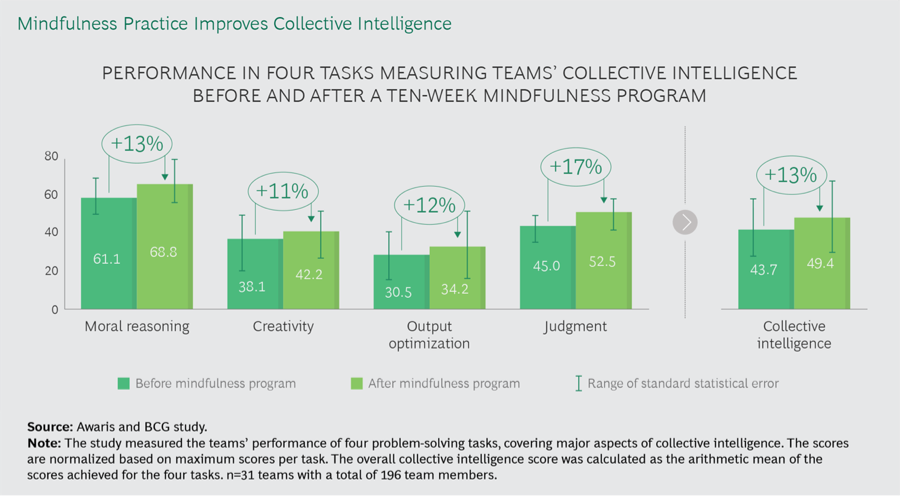Companies increasingly are setting up agile, cross-functional teams to tackle complex problems that need to be solved through teamwork and collective intelligence. Are there ways that firms can nurture these abilities among employees? According to research by Boston Consulting Group and Awaris, a ten-week mindfulness program can lead to a measurable increase in collective intelligence. This was the conclusion of a study involving 31 teams and 196 members. Christian Greiser, Jan-Philipp Martini, Liane Stephan and Chris Tamdjidi, the co-authors of this opinion piece, led the research study.
Greiser is a managing director and senior partner in the Düsseldorf office of Boston Consulting Group. He has practiced meditation for more than 15 years. Martini is a consultant in BCG’s Düsseldorf office. He has practiced Vipassana meditation for many years and leads BCG’s mindfulness network. Stephan is a co-founder and managing director of Awaris. She has practiced mindfulness for more than 35 years. Tamdjidi is a co-founder and managing director of Awaris and is responsible for the organization’s efforts relating to neuroscience research and technology. He has practiced mindfulness for more than 30 years.
Does mindfulness at the individual level foster an organization’s collective intelligence? A recent study conducted by Boston Consulting Group (BCG) and Awaris demonstrated a connection: 31 teams (totaling 196 people) that participated in a ten-week mindfulness program showed an average increase of 13% in collective intelligence, as measured by tests developed by the MIT Center for Collective Intelligence.
The concept of collective intelligence—the capability of a group of people to solve complex problems—is not new. But the increasing interconnectedness of knowledge work and the growing variety of problems have raised the profile of collective intelligence as a competitive differentiator. So, companies need to understand the concept more systematically and scientifically.
One key to unlocking the potential of collective intelligence is mindfulness—a state of being present in the moment and leaving behind one’s tendency to judge. Leading companies have introduced programs to unleash the power of mindfulness among their employees. But most of these companies have not focused explicitly on the opportunities to use mindfulness to foster collective intelligence. If implemented effectively, even relatively modest investments can generate outsize returns in team performance.
Solving Complex Problems with Collective Intelligence
Companies today must manage rapid innovation cycles and the deep interconnectedness of knowledge work. To address the challenges, many companies are investing in setting up cross-functional, agile teams. But to transition to truly dynamic ways of working, a company must fundamentally transform how cross-functional teams interact and collaborate. This requires bringing forth an emergent property of their system: the collective intelligence of their teams.
We define collective intelligence as a group’s ability to perform the wide variety of tasks required to solve complex problems. Collective intelligence is not dependent on team members’ IQ, knowledge, or ability to think logically or on the team’s composition. Instead, it is largely driven by team members’ unconscious processing: their emotional intelligence (people’s awareness of, and ability to manage, their own emotions and those of others) and emergent properties such as trust, emotional and psychological safety, and equality of participation. This description is supported by studies conducted by the MIT Center for Collective Intelligence and Google’s Project Aristotle. Our experience across a large number of transformations to new ways of working and agile methods also points to emotional and noncognitive factors as the key drivers of collective intelligence.
The Power of Diversity
Diversity is among the foundational elements of a team’s collective intelligence. In this context, diversity should not be limited to gender or functional and educational backgrounds. What’s required is a diversity of cognitive styles — that is, different ways of thinking about, perceiving, and remembering information or simply different ways of solving problems or seeing the world.
To tap into the power of diversity—with respect to both expertise and world views—a company must create an environment in which individuals are willing to risk stating their opinions and to be receptive to listening to others. This requires integrating a team’s diversity.
Teams whose members are not well integrated exhibit many dysfunctions. Members often lack a sense of joint purpose and struggle to engage in teamwork. The failure to properly integrate a team’s diversity can actually diminish its collective intelligence.
Mindfulness as a Potential Solution
Companies already apply approaches that foster collective intelligence. They are increasingly proficient at setting up diverse teams, breaking down organizational silos, and implementing open information systems. However, companies often do not explicitly recognize how these efforts relate to collective intelligence and thus they fail to capture the full benefits.
“Just as manufacturers track physical safety, companies should track emotional or psychological safety in their knowledge environments.”
Most notably, companies are not doing enough to identify and address inadequate emotional safety and trust among team members. That is because most companies are not sufficiently aware of people’s unconscious interactions and do not understand how unconscious factors influence team performance. Most companies also lack the skills and perseverance to constructively address issues related to emotional safety and trust.
Mindfulness provides a potential solution for meeting these challenges. Many companies have introduced mindfulness into their organizations, primarily to help their employees maintain well-being and improve their clarity of thinking, cognitive abilities, and ability to stay calm. However, only a few organizations (including the European Commission, Google and Hilti) have also applied mindfulness to transform the collective capabilities of teams.
Most people who regularly practice mindfulness have an intuitive understanding of its connection to collective intelligence. What’s more, the effect of mindfulness practice on collective intelligence is objectively measurable. Awaris and BCG conducted extensive research to confirm the hypotheses of this article. We measured the collective intelligence of 31 teams, totaling 196 people, from a large German automotive company and a political organization. We took measurements twice — before and after a ten-week mindfulness program. After the mindfulness program, the teams’ collective intelligence — measured through four diverse problem-solving tasks—increased by an average of 13%. (See the exhibit below.) Moreover, we found that mindfulness is significantly associated with emotional intelligence and that individual and group mindfulness scores predicted a team’s collective intelligence.
Mindfulness practice fosters collective intelligence by allowing us to redirect our mental attention skills (for example, capabilities of the working memory or our ability to focus on the task at hand) toward more expansive, awareness-based skills. More specifically, mindfulness practice strongly influences a person’s self-awareness of the body’s internal state (interoception) and mental processes (metacognition). Interoception and metacognition help us regulate our reactions to emotions and behaviors. By improving our ability to get in touch with our own emotions, we also enhance empathy — our ability to vicariously share the experiences of others.
By increasing self-awareness and empathy, mindfulness impacts two areas that directly promote collective intelligence:
- Communication and Prosocial Behavior: Team members who embrace mindfulness are better listeners and can react in an emotionally intelligent way when tension or disagreement arises. Their style of interaction encourages other team members to speak up and participate in creative processes and allows them to integrate their diverse cognitive styles.
- Leadership: Mindfulness training helps leaders improve their ability to self-reflect. Mindfulness is also associated with important leadership capacities such as flexibility, authenticity, and humbleness.
Three Steps to Applying Mindfulness
To use mindfulness to foster collective intelligence, a company must take three steps.
- Provide mindfulness training. Mindfulness practice comprises a set of mental and emotional exercises that affect the functioning of the brain in a measurable way. Several proven methods of mindfulness training can help team members and leaders establish a personal mindfulness practice. For example, companies can apply a ten-week program — as we did for our study — that begins with a workshop that explains the neurophysiological basics of mindfulness and its impact on collective intelligence. The workshop is followed by a practice period supported by a mindfulness app, frequent webinars, coaching, and peer-to-peer learning groups so that individuals learn to make mindfulness practice a daily routine.
- Anchor mindfulness in teams. Mindfulness can evolve from a practice to a state and eventually become a trait — when the various underlying skills have become embedded in a person’s mental and emotional makeup. Team interactions provide valuable opportunities to embed these skills. To promote mindfulness, organizations must clearly state that teams should practice three simple types of habits that foster psychological safety and collective intelligence:
-
- Attention and Focus. Teams need to establish specific habits that promote attentiveness. For example, a team can observe one minute of silence before the start of each meeting. In addition, how team members deal with devices, listen to each other and speak can significantly affect the degree of presence and openness in the meeting.
-
- Care and Positivity. When people feel trust, efficacy, and appreciation, they engage and contribute. But when they do not, they hold back and divert their energy to other things. As a result, demonstrating care and positivity in teamwork — noticing what colleagues have achieved and done well and appreciating their contributions — can be very important to improving the sense of bonding and community.
-
- Emotional Awareness. Team members should allow emotions to surface so that expressing emotions becomes a natural part of what it means to work together. Processes for surfacing emotions include having check-ins during which team members share how they feel emotionally before a meeting, as well as regular retrospectives in which members share their feelings on the interactions within their team.
- Establish metrics and track behavior changes. Just as manufacturers meticulously track physical safety on their shop floors, companies should track emotional or psychological safety in their knowledge environments. As a starting point, companies can use surveys and interviews to ask employees whether they believe the company has clearly articulated that emotional safety and psychological safety are goals and whether they understand how to create such safety.
To start using mindfulness to foster collective intelligence, executives can launch a ten-week mindfulness coaching program with a few teams and measure the impact. The results of this pilot will likely demonstrate that mindfulness has a positive impact on team performance and inspire a company-wide discussion about the value of collective intelligence and psychological safety.
Following a successful pilot, a company can adapt mindfulness training and habits to suit its culture and roll out a program across the organization. To convince the skeptics, it is essential to apply deep expertise in mindfulness training. Those companies that succeed will fully realize their collective intelligence and thereby reap the rewards of new ways of working and cross-functional teamwork.




